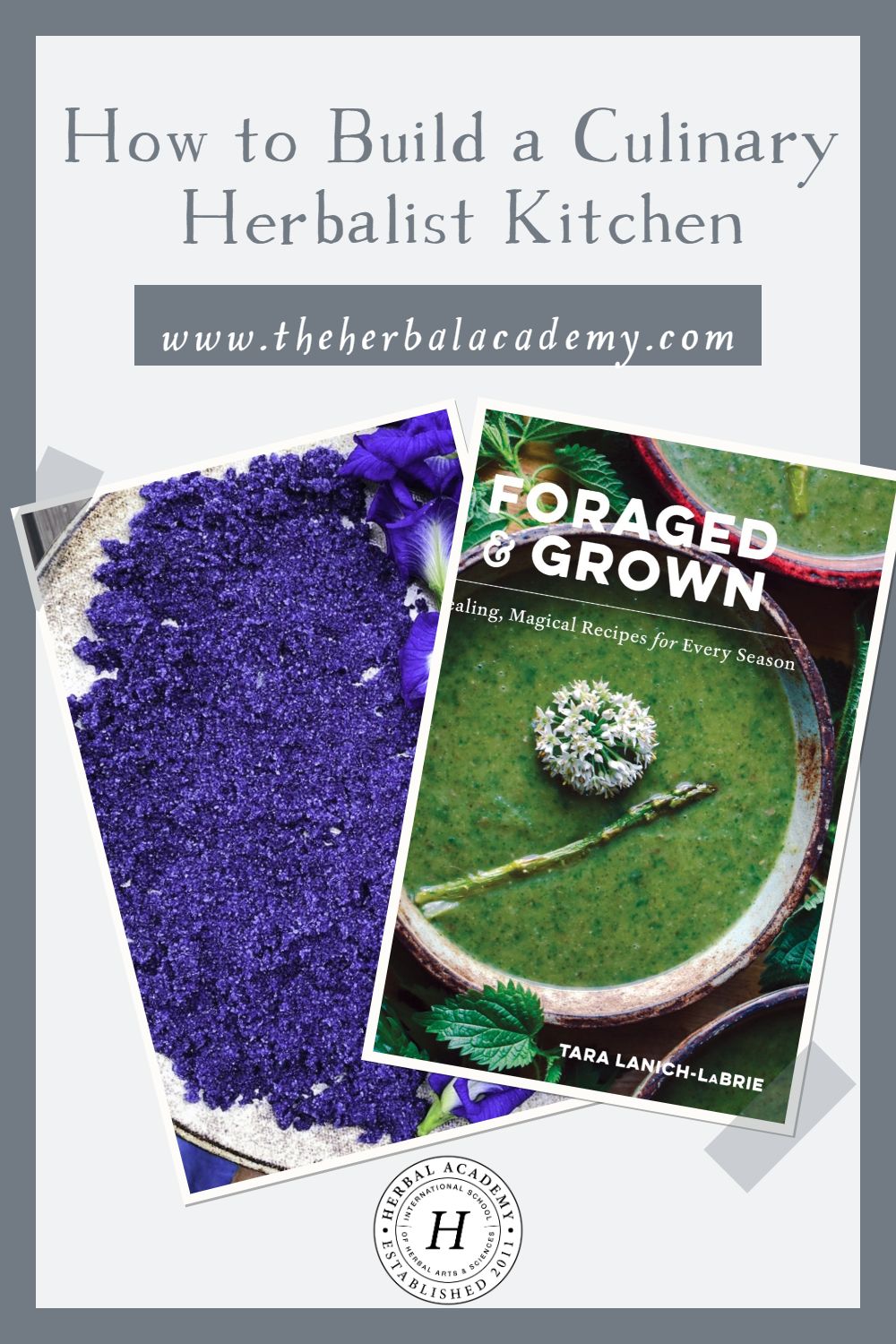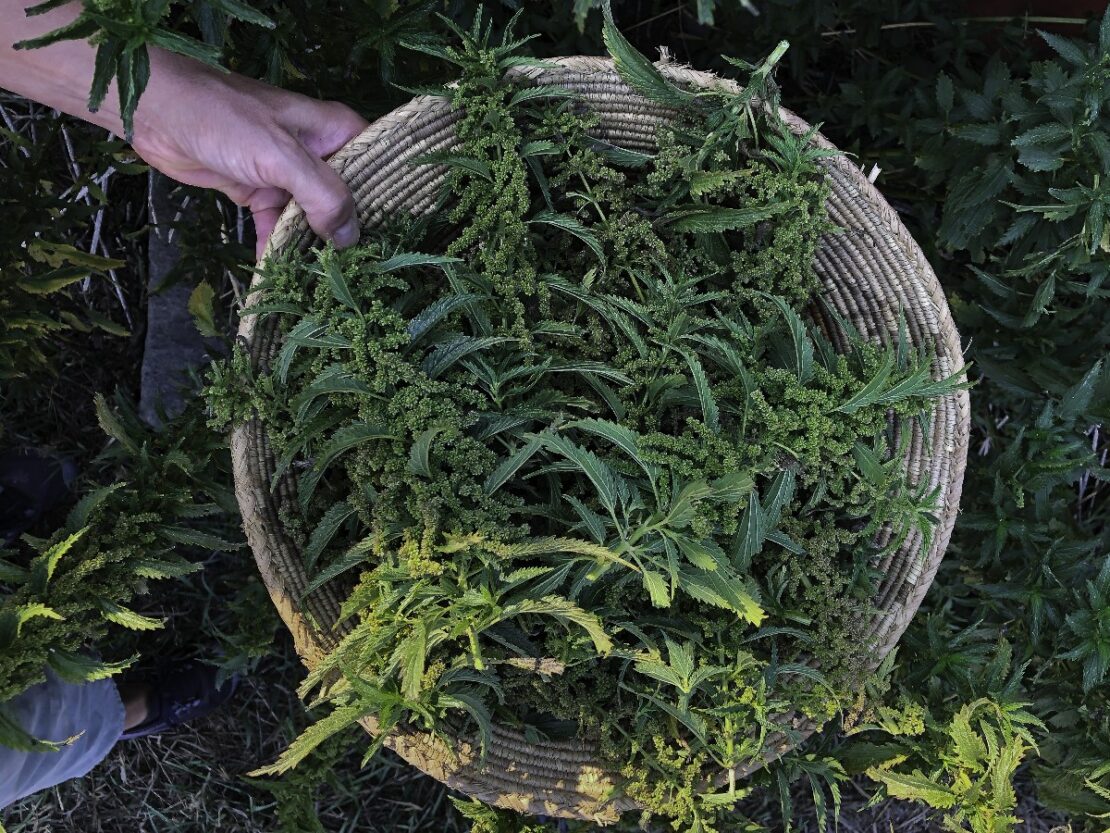
How to Build a Culinary Kitchen for Herbalists
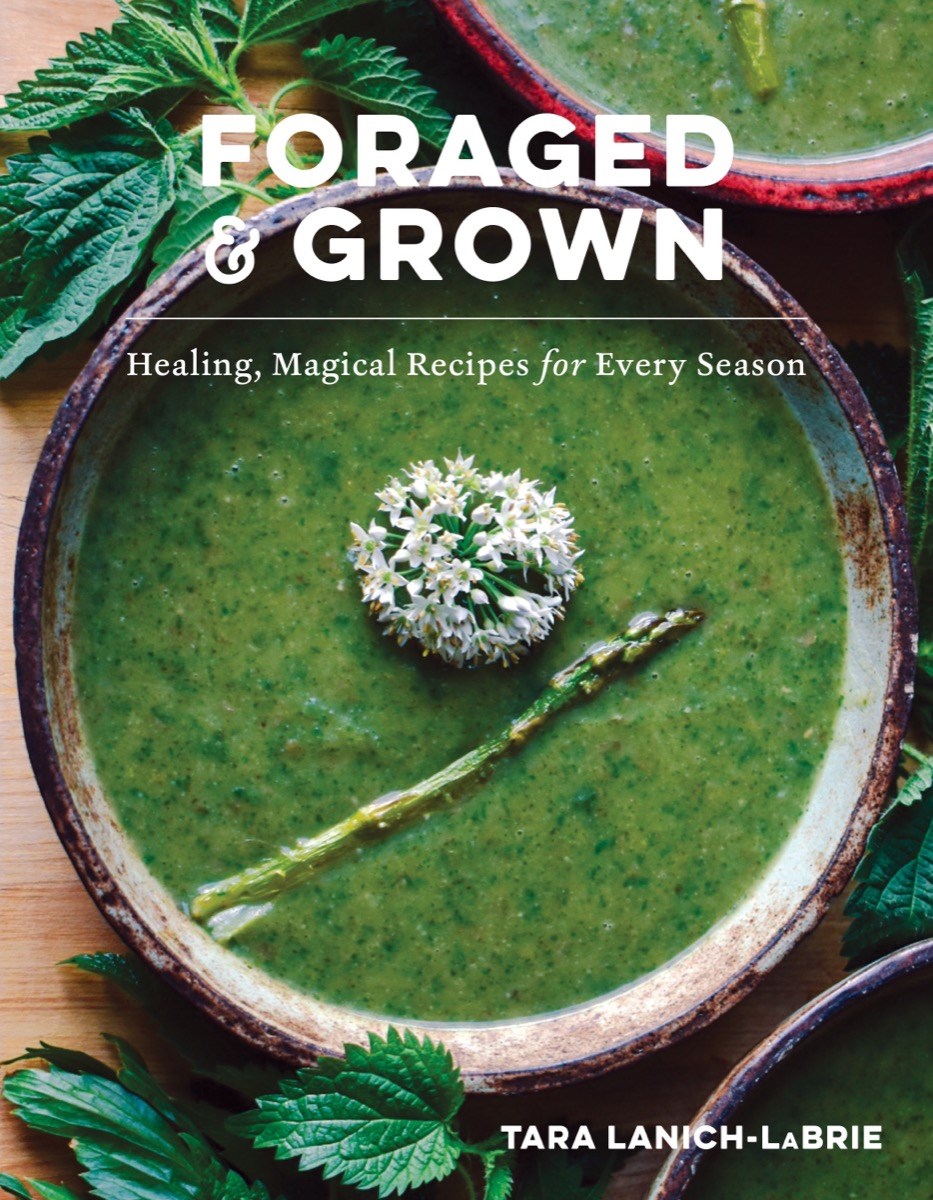
The following excerpt is taken from the book Foraged & Grown by Tara Lanich-LaBrie. Tara takes us on a culinary kitchen journey to reconnect with our body and the natural world with 100 plant-inspired recipes.
Foraged and Grown is a herbalist’s culinary kitchen journey through the seasons with recipes that highlight herbal ingredients and share their use in various historic folk traditions. From Nettle Gnocchi and Hollyhock Wraps to Rose Roll-Out Cookies and Dandelion Root Drinking Chocolate, readers are in the hands of an expert who alchemizes foraged and grown plants into magic. Including a detailed plant guide, seasonal organization, and key ingredient swaps to make all recipes accessible, this is the perfect cookbook for anyone curious about the natural world, cooking with more plants, or eating with the seasons.
PANTRY ESSENTIALS
This is a list of ingredients I keep stocked in my culinary kitchen pantry most of the year, and many of these ingredients are used throughout the book. There is an array of dried plants, mushrooms, and flowers to add color and beauty, flavor, medicinal benefits, nutrients, and minerals. I also powder my herbs, flowers, and mushrooms to add to such recipes as doughnuts or sauces, and this allows for quick and easy additions to regular meals. Everything in the book is gluten- and dairy-free and most things are preserved or sweetened with either maple syrup, coconut sugar, or honey. To be able to cook these recipes, I would recommend stocking your culinary kitchen up on the following ingredients more regularly:
Coconut Flour: Coconut flour is very dense, so a little goes a long way. It can be excellent for baking and is a favorite for people who are grain-free. It is high in healthy fats and protein.
Oat Flour: Oat flour is a favorite of mine because it is easily made at home, accessible, and inexpensive. Oats are also a medicinal herb, and the flour is quite versatile. Some people are allergic or sensitive to oats, especially if they have celiac disease, and sorghum flour is often a good replacement.
Garbanzo Bean Flour: Garbanzo bean flour is used all over the world to make savory gluten-free foods. It is made from ground garbanzo beans (also known as chickpeas or besan) and is a favorite for its buttery, slightly nutty flavor and smooth texture, lending itself to savory pancakes and battered, fried foods.
Nut Flours: In this book, I use almond, chestnut, and hazelnut flours. All three flours are ground from the nut in their name; in many of the recipes, they can often be used interchangeably. However, almond flour tastes mild and buttery, whereas chestnut and hazelnut flours are much stronger in flavor. They all work well combined with other gluten-free flours and in baked goods.
Buckwheat Flour: Buckwheat is gluten-free, and it is technically the seed of a fruit, making it what is called a pseudocereal. It is a good source of fiber, is rich in minerals, and has an almost nutty flavor. Buckwheat helps increase glutathionine, a powerful antioxidant; it may be anti-inflammatory and anticancer, and has been used to help lower cholesterol and balance blood sugar.
Cornmeal and Masa: Cornmeal is dried corn, ground to different consistencies. In this book, the cornmeal is ground fine for the recipes shared. Masa is also corn, but it has been nixtamalized, an ancient process from Aztec culture, of boiling corn with ashes or slaked lime, also called cal, that strips the corn of the pericarp, the outer casing of the kernel, and alchemizes the corn into an extremely delicious, nutrient-dense food. Masa flour is very different in texture from cornmeal and cannot be substituted.
Tapioca Flour and Starch: Tapioca is derived from cassava root, but is made up of only the starchy part of the plant. It is an excellent thickening agent and helps provide a glutinous feel to baked goods.
Sweet White or “Glutinous” Rice Flour, a.k.a. Mochiko: Sweet rice flour is not literally glutinous, but is made from sticky rice, giving it a higher starch content than other rice flours. It is excellent for building body and structure in gluten-free baking and is also the essential ingredient in mochi.
Sorghum Flour: Sorghum is a grass seed that is ground to make a mild and lightly sweet flour. It is an ancient grain from Africa that has been used for more than 5,000 years. It can replace oat flour and works well in baked goods.
Flaxseeds: Flaxseeds are high in fiber, omega-3 fatty acids, and lignans. They can be ground and mixed with water to make an egg substitute for some baked goods.
Maple Butter: Maple butter contains no butter at all; it is maple syrup cooked down and reduced to a soft and creamy spread. I use it frequently as a glaze and icing for baked goods. It dries glossy and tastes like maple syrup. Creamed honey will often work to replace maple butter, but it will have a sweeter taste and slightly different texture.
Maple Syrup: Pure maple syrup is my favorite sweetener, and it is my primary source of sugar in baking. Maple syrup has been used for hundreds of thousands of years and was first made by Native Americans by boiling the running sap of the sugar maple tree. It is fairly high in manganese and riboflavin, and small amounts of calcium, potassium, and zinc. The syrup also contains antioxidants, so although it is definitely sweet, it adds a depth of flavor and has beneficial properties.
Honey: This is another favorite sweetener that has been used for thousands of years as a preventative and curative medicinal. Honey has been used as a powerful anti-viral and antibacterial, and is employed in many hospitals outside the United States for burns and wound healing. I use honey to preserve and add flavor to a number of dishes throughout the book, for medicinal remedies, as well as in desserts and dressings.
Coconut Sugar: Coconut sugar is harvested from the sap of coconut palm flowers, and it is slightly lower on the glycemic index than cane sugar. It has a light caramelized flavor, similar to that of brown sugar, and can be replaced with cane sugar in any of the recipes in the book.
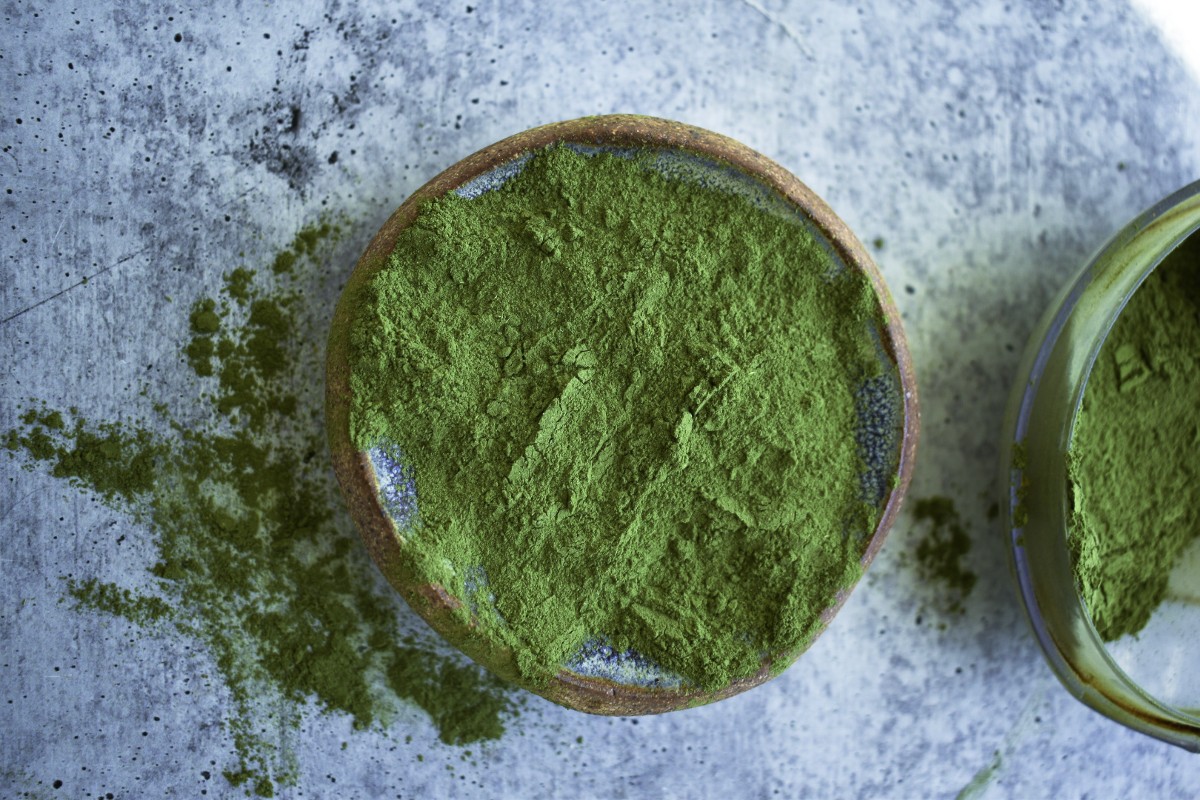
Nettles: I drink regular infusions of nettle all year-round, and I powder it in a spice or coffee grinder to use in baked goods, pasta, smoothies, and other recipes. I keep nettle leaf dried in sealed jars for use through all the seasons. It adds color, medicinal properties, and bright flavor to everything it touches. Nettle powder is one of my most used pantry items. I also reserve at least an 8-ounce jar of nettle
seeds to use as a garnish and energizing addition to meals. Nettles are an adaptogenic plant, meaning they are known to support the body in lowering stress levels and increasing energy. Learn more about nettles on page 30.
Rose Petals: Fragrant, unsprayed rose petals are essential in the culinary herbalist’s pantry. They have so many uses, from garnishing to powdering and flavoring, as well as adding to both sweet and savory dishes. Roses are a flower of the heart, and they are an astringent, cooling, and gentle herb that has been used for thousands of years across the world.
Rose Hips: I love to have this sweet “fruit” of the rose, dried and seeded for use in both powder and whole forms. Rose hips must be seedless if used in a powder form, and strained if they have seeds, as the seeds themselves contain irritating hairs. Rose hips are extremely high in vitamin C and add a vibrant and lightly citrus flavor to both savory and sweet meals. Learn more about rose hips on page 33.
Marigolds: Marigolds are one of my favorite edible flowers, both dried and fresh, because they retain their vibrancy and color when dry and in baking. I love the deep orange marigolds for a pop of sunshine in the winter months, and they have been used as a medicinal herb for hundreds of years in several different cultures.
Butterfly Pea Flowers/Powder: Butterfly pea flowers are my favorite culinary and medicinal flower. They are one of the only naturally blue edible flowers in the world. They contain large amounts of anthocyanin, an antioxidant that is known to support heart health. They are adaptogenic, and have been used as a brain tonic and aphrodisiac in Ayurvedic medicine and other traditional medicine practices for more than 4,000 years.
Liquid Chlorophyll Concentrate: This is a deep green, natural concentrate that I use to color things brighter shades of green, to bring people into the full story of such plants as nettles. It is often made from nettles or alfalfa, both rich sources of chlorophyll.
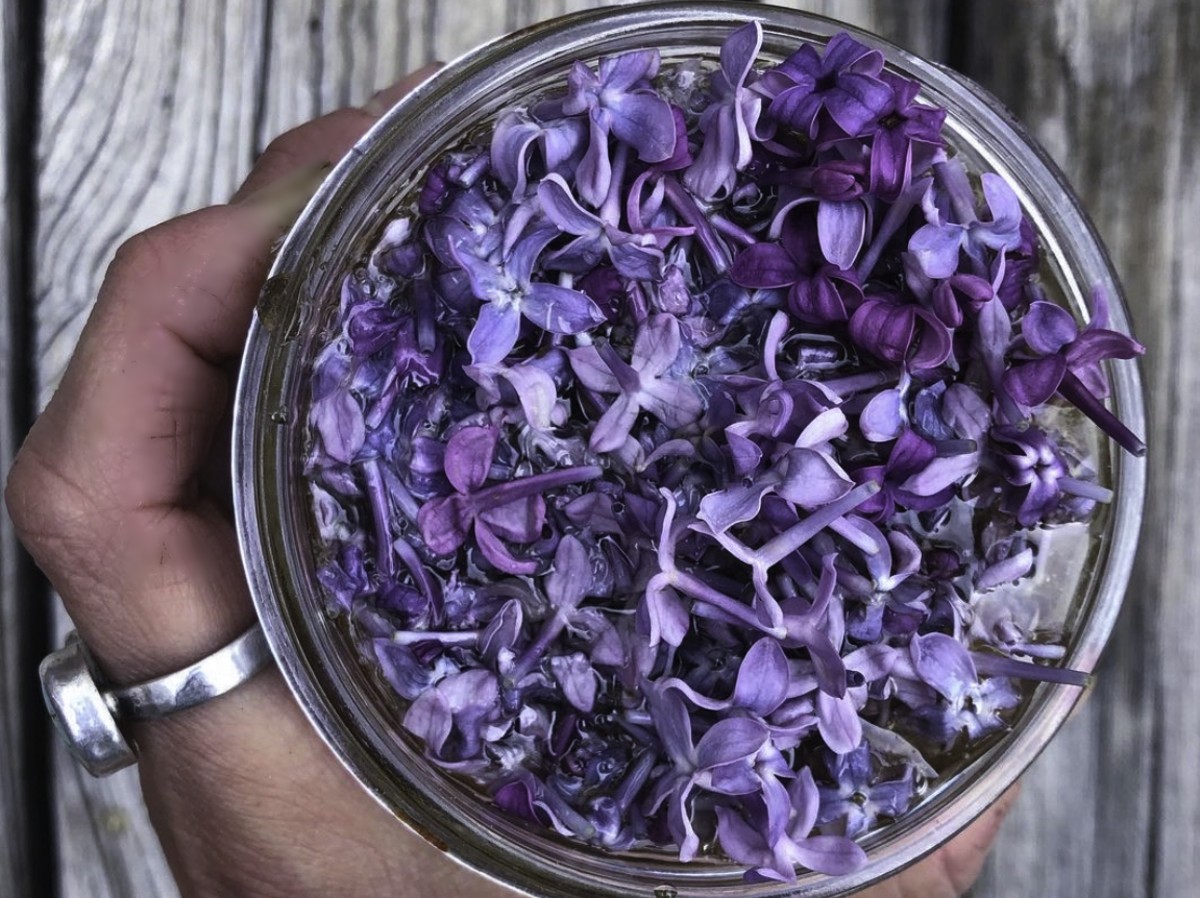
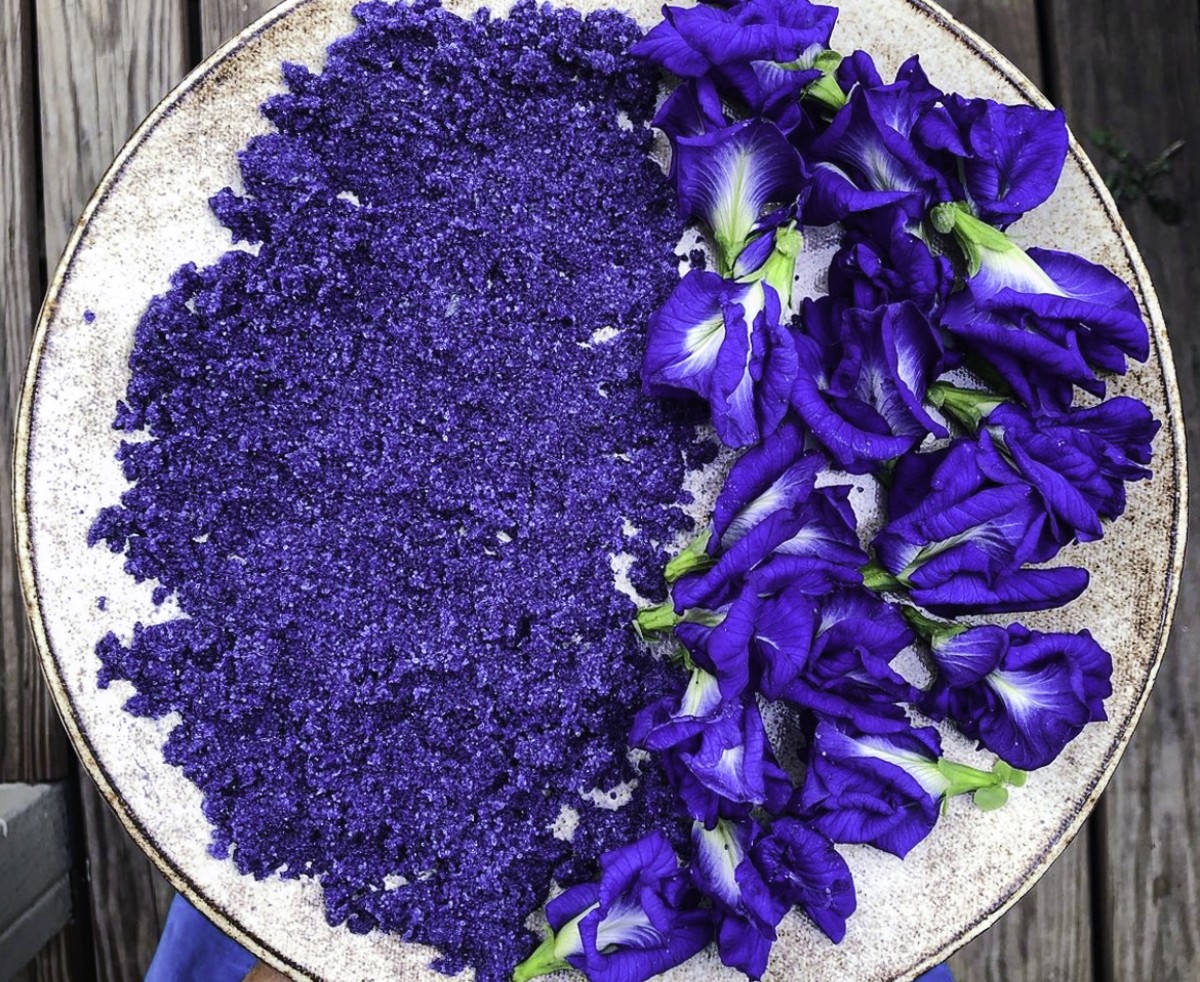
HERB AND FLOWER POWDERS
My most oft-used culinary kitchen tool is an old electric coffee grinder, with a worn and handwritten label of “Flowers & Herbs,” that I use to grind nettles, seeded rose hips, roasted dandelion root, wild mushrooms, and so much more. One of the most important ingredients in culinary kitchen herbalism, seasonal cooking, and my home pantry are the dried herbs I collect and preserve. I live in an area that only has fresh plants and flowers for about five months of the year, so I dry many of my herbs, mushrooms, and flowers to use in the other seven months.
Culinary and medicinal herbs and mushrooms provide color, flavor, nutrients, and medicinal benefits to smoothies, soups, baked goods, pastas. . . the possibilities are endless! Any dried herbs or herbal teas can be used, whether they are foraged, grown, or purchased.
To powder your favorite ingredients, start with completely dry herbs, roots, mushrooms, seeds, or flower petals. Not all herbs or petals are perfect for blending, but many will work beautifully. Place about ¼ cup of plant material at a time in a clean coffee grinder, spice grinder, or high-speed blender. Blend on high speed for about 30 seconds, or until the plant material is a fine powder. Place a mesh sieve over a medium bowl, and pour the powdered plant material into the sieve. Tap it until all the powdered material is finely sifted into the bowl. Discard or use any larger leftover bits, and store the powder in a sealed container with a dated label. Use as needed, and enjoy added to your favorite meals and drinks.
Note: Plants must be completely dry and cooled before powdering. For example, if you are roasting dandelion root, let it cool completely before blending.
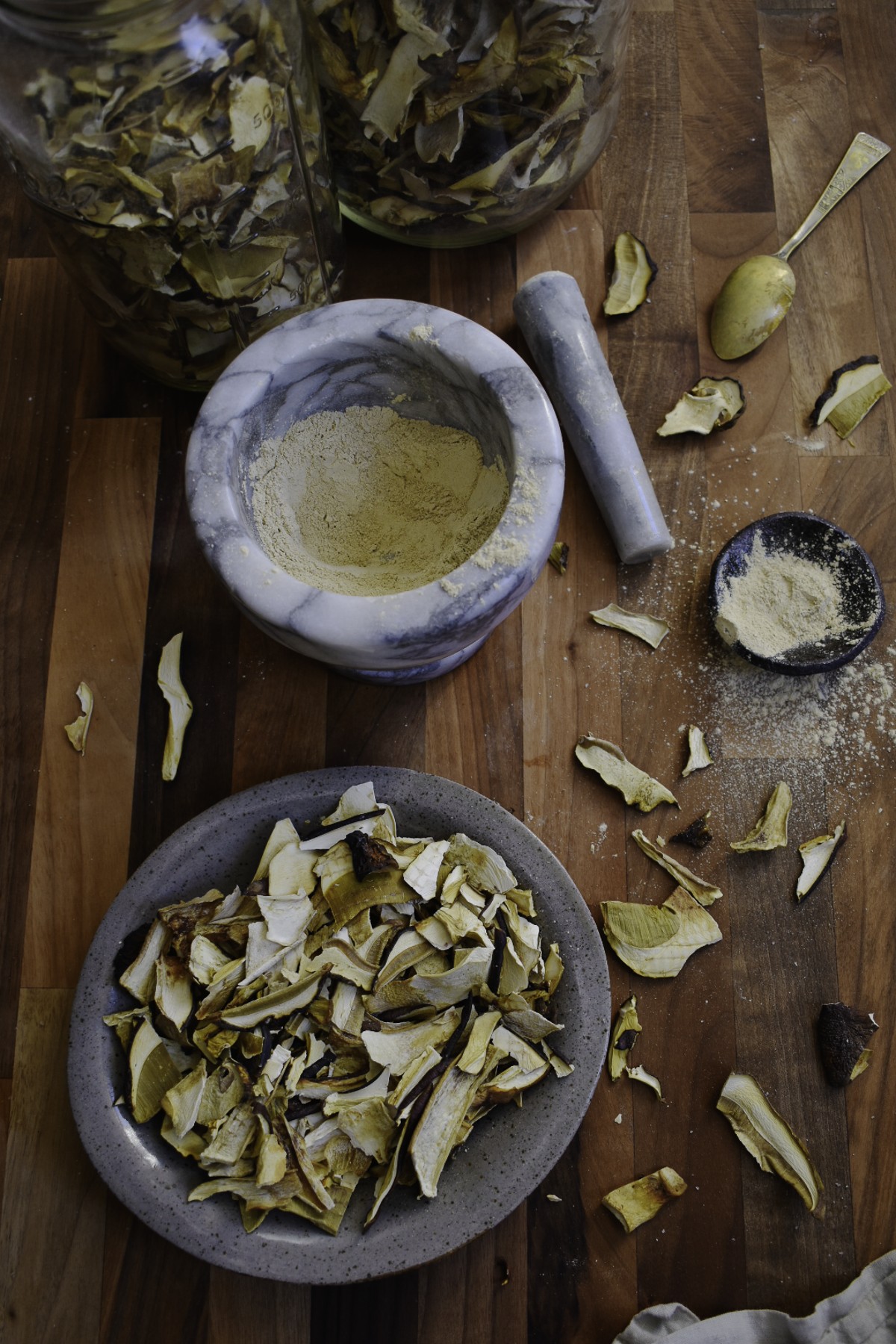
KITCHEN ESSENTIALS
These are the culinary kitchen tools I have found helpful for processing and preparing seasonal and foraged foods, herbs, and mushrooms. There are always ways to work around things if you don’t have the following items, but this list is a good starting place for any foraging and
herbalist culinary kitchen.
Coffee or Spice Grinder for Plants: This is one of the most essential items in my kitchen. I use an old coffee grinder to powder mushrooms, dried flowers, and herbs to add to meals and baked goods.
Doughnut Molds: I use a nine-doughnut silicone mold made by the Wappa brand for all my cake doughnuts. It is a standard-size
doughnut mold and distributes heat well across the bake.
Baking Sheets: I use baking sheets for everything from drying plants and salts to winnowing seeds, and of course, baking. Baking sheets have a shallow rim that comes up all the way around the perimeter of the sheet.
Blender, Food Processor, or Both: High-speed blenders are great for getting the smoothest, creamiest textures, and some blenders can grind grains into flour. Food processors are helpful for processing plants and sauces quickly and easily.
Ice-Cream Maker: If you love ice cream or sorbet, this is a fantastic tool. I have had my ice-cream maker for 13 years and I use it regularly for making ice creams and sorbets with foraged plants and herbs, such as my Spruce Tip Mochi Ice Cream (page 71).
Cast-Iron Skillets: Cast-iron skillets are the most important kitchen tool I own because they are incredibly versatile and conduct heat evenly. Cast iron can be used for stovetop cooking, baking at high temperatures, and cooking over a fire.
Mortar and Pestle: A mortar and pestle are excellent for grinding up spices, pestos, and herbs, and pounding dry and wet ingredients to add to various dishes.
Dehydrator: A dehydrator is an excellent tool for drying and preserving the seasonal harvests, both foraged and grown. I run dehydrators all season long to preserve herbs, mushrooms, fruits, and flowers for the off-season. Dehydrators can be an investment, although I have found them inexpensively in thrift stores. But even so, it is not necessary to start drying all your flowers, herbs, or even mushrooms with a dehydrator. Using an oven on the lowest setting, hanging herbs to dry in bundles, or laying out flowers on a dry towel can work just as well. If air drying, be sure they are in a dry, well-ventilated, unlit area. It is important to label all your herbs as they are drying because they can look very different from when they are fresh. Place in airtight containers and label their containers once they are completely dry; most herbs will keep for 6 months to a year in sealed containers out of direct sunlight.
Sharp Knives/Knife Sharpener: Sharp knives are important when you’re cooking or foraging. If your knife is dull, it is much more likely to slip and cause an injury. You can also get thinner and more accurate slices with a sharp knife. Getting a basic knife sharpener is inexpensive and completely worth it. In my everyday cooking, I use a chef’s knife, a nakiri knife (a Japanese knife designed for slicing vegetables), and a paring knife. It does not really matter which kind of knife you are using, as long as it is sharp and feels good to you.
Mason Jars in Various Sizes: I use mason jars for preserving pickles and medicinal herbs, fermentations, the storage of herbs and driedgoods, and to refrigerate, can, or otherwise preserve the seasonal harvest.
|
Ingredients |
Grams Per 1 US Cup |
Grams Per 1 US Tablespoon |
| Almond Flour | 100 |
6 |
|
Oat Flour |
120 |
7.5 |
|
Tapioca Flour/Starch |
115 |
7 |
|
Vegan/Dairy Butter |
226 |
14 |
|
Coconut Oil, melted |
220 |
14 |
|
Maple Syrup |
315 |
20 |
| Honey | 350 |
22 |
| Coconut Sugar | 180 |
11 |
|
Whole Oats |
100 |
6 |
|
Nettle Leaf, fresh |
22 |
X |
|
Porcini Mushroom Powder |
X |
7 |
|
Rose Powder |
X |
5 |
|
Rose Hips, seeded |
X |
5 |
|
Butterfly Pea Powder |
X |
5 |
|
Baking Soda |
X |
18 |
| Baking Powder | X |
12 |
Get a copy of Foraged & Grown on Amazon and learn how to build a culinary kitchen for herbalists.
